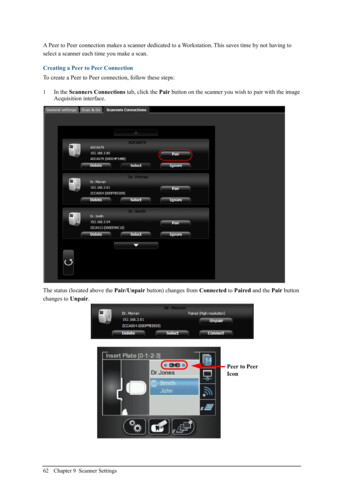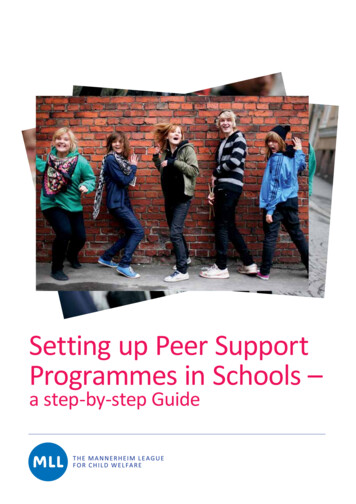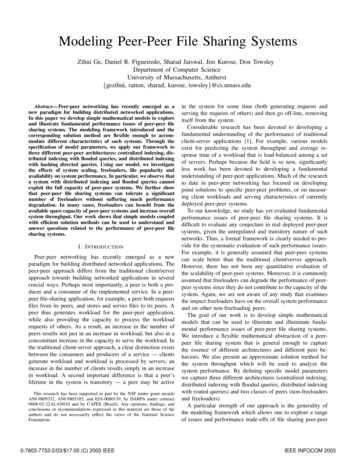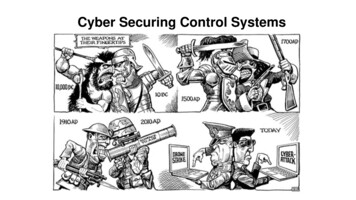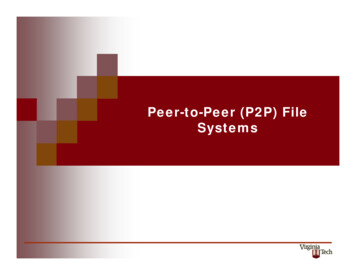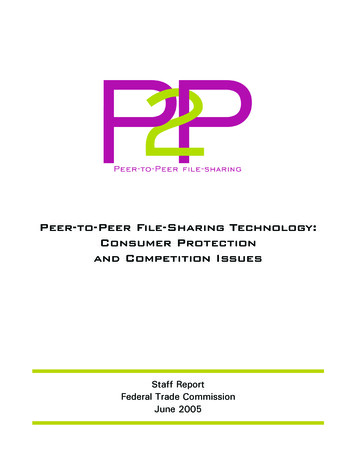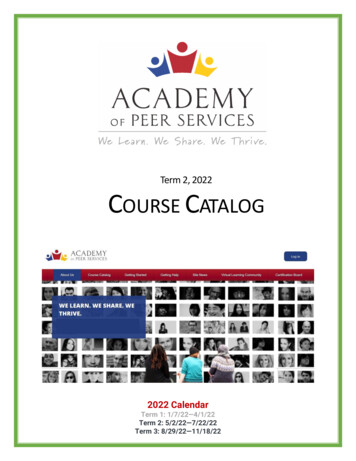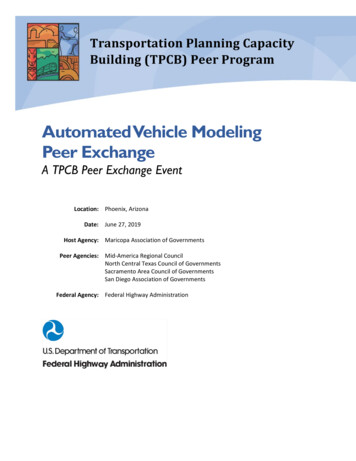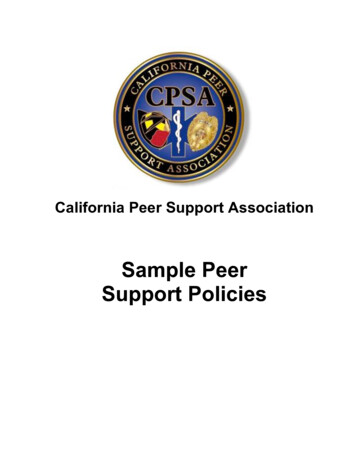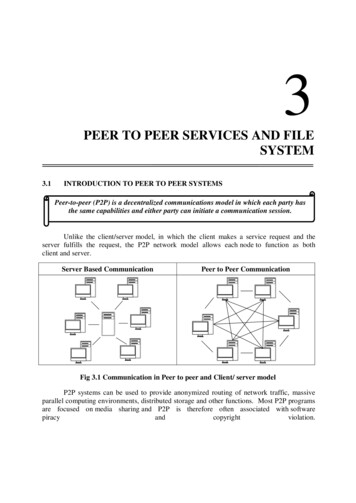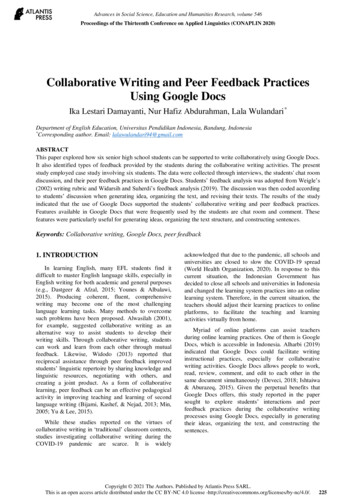
Transcription
Advances in Social Science, Education and Humanities Research, volume 546Proceedings of the Thirteenth Conference on Applied Linguistics (CONAPLIN 2020)Collaborative Writing and Peer Feedback PracticesUsing Google DocsIka Lestari Damayanti, Nur Hafiz Abdurahman, Lala Wulandari *Department of English Education, Universitas Pendidikan Indonesia, Bandung, Indonesia*Corresponding author. Email: lalawulandari94@gmail.comABSTRACTThis paper explored how six senior high school students can be supported to write collaboratively using Google Docs.It also identified types of feedback provided by the students during the collaborative writing activities. The presentstudy employed case study involving six students. The data were collected through interviews, the students' chat roomdiscussion, and their peer feedback practices in Google Docs. Students’ feedback analysis was adopted from Weigle’s(2002) writing rubric and Widarsih and Suherdi’s feedback analysis (2019). The discussion was then coded accordingto students’ discussion when generating idea, organizing the text, and revising their texts. The results of the studyindicated that the use of Google Docs supported the students’ collaborative writing and peer feedback practices.Features available in Google Docs that were frequently used by the students are chat room and comment. Thesefeatures were particularly useful for generating ideas, organizing the text structure, and constructing sentences.Keywords: Collaborative writing, Google Docs, peer feedback1. INTRODUCTIONIn learning English, many EFL students find itdifficult to master English language skills, especially inEnglish writing for both academic and general purposes(e.g., Dastgeer & Afzal, 2015; Younes & Albalawi,2015). Producing coherent, fluent, comprehensivewriting may become one of the most challenginglanguage learning tasks. Many methods to overcomesuch problems have been proposed. Alwasilah (2001),for example, suggested collaborative writing as analternative way to assist students to develop theirwriting skills. Through collaborative writing, studentscan work and learn from each other through mutualfeedback. Likewise, Widodo (2013) reported thatreciprocal assistance through peer feedback improvedstudents’ linguistic repertoire by sharing knowledge andlinguistic resources, negotiating with others, andcreating a joint product. As a form of collaborativelearning, peer feedback can be an effective pedagogicalactivity in improving teaching and learning of secondlanguage writing (Bijami, Kashef, & Nejad, 2013; Min,2005; Yu & Lee, 2015).While these studies reported on the virtues ofcollaborative writing in ‘traditional’ classroom contexts,studies investigating collaborative writing during theCOVID-19 pandemic are scarce. It is widelyacknowledged that due to the pandemic, all schools anduniversities are closed to slow the COVID-19 spread(World Health Organization, 2020). In response to thiscurrent situation, the Indonesian Government hasdecided to close all schools and universities in Indonesiaand changed the learning system practices into an onlinelearning system. Therefore, in the current situation, theteachers should adjust their learning practices to onlineplatforms, to facilitate the teaching and learningactivities virtually from home.Myriad of online platforms can assist teachersduring online learning practices. One of them is GoogleDocs, which is accessible in Indonesia. Alharbi (2019)indicated that Google Docs could facilitate writinginstructional practices, especially for collaborativewriting activities. Google Docs allows people to work,read, review, comment, and edit to each other in thesame document simultaneously (Deveci, 2018; Ishtaiwa& Aburazeq, 2015). Given the perpetual benefits thatGoogle Docs offers, this study reported in the papersought to explore students’ interactions and peerfeedback practices during the collaborative writingprocesses using Google Docs, especially in generatingtheir ideas, organizing the text, and constructing thesentences.Copyright 2021 The Authors. Published by Atlantis Press SARL.This is an open access article distributed under the CC BY-NC 4.0 license 5
Advances in Social Science, Education and Humanities Research, volume 5461.1. Literature Review1.1.1.Collaborative WritingCollaborative writing is an activity in which studentswork collaboratively in producing a single paper(Howard, 2001). Collaborative writing is also defined asan activity to produce a text conducted by two or morepeople (Storch, 2011). From both definitions,collaborative writing can be defined as an activityinvolving two or more students working together toproduce a single text. The students are encouraged tocollaborate throughout the writing processes.The collaborative writing activity is oftenimplemented in the second language classroom topromote an interactive classroom atmosphere (Storch,2013). As an instructive and interactive activity,collaborative writing has been increasingly adopted inthe second language (L2) classrooms over the pastdecades (e.g., Dobao, 2012; Storch, 2005; Wigglesworth& Storch, 2012). A number of studies investigatingcollaborative writing practices in L2 classroomsreported that collaborative writing tasks are beneficial ina way that they offer more learning opportunities suchas reading and discussions among the students, leadingto better learning outcomes (Li & Zhu, 2017; Zhang,2018).Collaborative writing activity is informed by thesocial constructivist theory of learning Vygotsky’stheory (1978) that learning is a social activity. In otherwords, the learning process is not an individual activity,but it is a cognitive activity that turns the focus oflearning from an individual context to an interactionwithin a social context (Fung, 2010). Therefore, thestudents develop knowledge through the socialinteraction processes with others. As in collaborativewriting, the students work together in two or morestudents to share knowledge and linguistic resources,negotiate with others and create a joint product(Widodo, 2013). Likewise, Chen (2014) states thatthrough collaborative learning, learning and knowledgeare made socially through communication andinteraction among the students in a community.Collaborative writing processes involve a series ofwriting stages such as prewriting, drafting, responding,revising, and editing (Mulligan & Garofalo, 2011;Shehadeh, 2011; Storch, 2005; Widodo, 2013). Thewriting processes include the followings. 1) Prewritingas the beginning part of the writing stages involvesforming the group, teacher’s support, and generatingideas. Forming the group can be done based on theteacher’s decision, students’ preferences, genders,students’ proficiency levels, interest, and the topic.Strategies in generating ideas can include reading(extensively) a passage, skimming and scanning apassage, conducting some research, brainstorming,listing, clustering, discussing a topic or questions,instructor-initiated questions and probes, andfreewriting (Brown, 2000). 2) Drafting aims to supportstudents to develop their ideas collaboratively into aniterative cycle of drafting with less concern on linguisticcomponents such as vocabulary and grammar. 3)Responding is a stage in which both the teacher andpeers provide feedback or comments on students’ worksregarding the content (ideas), rhetorical organization,and language form (vocabulary and grammar). 4)Revising and editing allows the students to rewrite theirdraft based on the feedback they received.1.1.2. Peer FeedbackIn the educational context, feedback is defined asinformation given to students of how successfully theprojects have been or are being conducted (Sadler,1989). Over the past twenty years, writing pedagogyand research have proposed a variety of feedbackpractices. Hyland (2006), for example, highlights thatteachers’ written feedback is often supplemented bypeer feedback, workshops of writing, conferences, andeven computer-mediated feedback. In a similar vein,Khalil (2018) underscores the importance of peerfeedback in addition to the teachers. Peer feedback, alsoknown as peer evaluation, peer response, peer editing,and peer review, is considered as one of the essentialtools in enhancing the process of language learning,especially in writing (Bijami, Kashef, & Nejad, 2013,Tsui & Ng, 2000). It has been pedagogically determinedas one of the effective methods to improve students’writing skill performances (Farrah, 2012).Peer feedback plays an important role incollaborative learning activities (Wakabayashi, 2016).The students work together to provide and share theiropinions on one another’s drafts in both written and oralformats to improve their writing skills (Farrah, 2012).The process of peer feedback practices enhances thestudents’ awareness of their own mistakes by readingtheir peers’ writing assignments (Tsui & Ng, 2000).Feedback is divided into two types, such as directfeedback and indirect feedback (Bitchener & Ferris,2012). In direct feedback, the teachers not only mark thewrong sentences on the text, but they also provide thefeedback along with some suggestions or examples ofits correct form. Indirect feedback refers to the teachergiving feedback without telling or suggesting the correctone.Direct feedback is categorized into four categories,such as deletion, insertion, substitution, andreformulation (Widarsih & Suherdi, 2019). Deletion is atechnique of giving feedback that removes a wrongword in the text. Insertion is inserting the correct wordin a text or sentence that is considered incomplete.Substitution is replacing a wrong word with a correctword. Reformulation is rewriting the wrong part of the226
Advances in Social Science, Education and Humanities Research, volume 546text and giving it suggestions to write it in the correctform.Indirect feedback is categorized into threecategories, namely coded feedback, uncoded feedback,and commentary (Widarsih & Suherdi, 2019). Codedfeedback is when the teachers mark the identified errorswith certain codes, for example, ‘ss’ (sentencestructure), ‘ww’ (wrong word), ‘vt’ (verb tense errors).In the uncoded feedback, the teachers mark the wrongsentences with the symbols ‘ ’ above the identifiederrors. Commentary is referred to the teachers’comments on what students have written about andseveral instructions for the students to improve theirwriting.Focus of feedback can include content, organization,vocabulary, language use, and mechanics (Weigle,2002). Content refers to the writing substance related tothe idea’s unity. Organization refers to the logical flowof ideas, text and paragraph structures. Vocabularyrefers to the word selection relevant with the contentand topic. Language use deals with the use of correctgrammar. Mechanics refers to the writing conventionsgoverning the writing technical aspects such aspunctuation, spelling, capitalization, and abbreviation.1.1.3.Google DocsThe development of computers and expandedinternet connection accessibility have contributed to theemergence of various resources to facilitatecollaborative writing practices. The development ofonline technologies web 2.0, including wikis, blogs,Google Docs, and another online forum, providesauthors, particularly teachers and students in theeducational context, with modern interactivetechnologies for collaborative writing practices (Limbu& Markauskaite, 2015). Online technologies andenvironments have provided new opportunities todevelop knowledge through interaction virtually duringthe writing processes (Nykopp, Marttunen, & Erkens,2018). Those platforms are designed to be highlyinteractive and collaborative, offering the virtual spacefor numerous authors to develop joint texts (Hadjerrouit,2011). However, those technologies alone cannotpromote a good learning activity without assistancefrom the entire learning ecology. It means that thesuccess and learning improvements not only rely onthose technologies themselves, but also the entirelearning ecology (Limbu & Markauskaite, 2015). Thus,the students’ participation in performing andcoordinating with their group has a vital role in thesuccess of online collaborative writing practices(Janssen et al., 2012).In recent decades, the technology of Web 2.0 hasdeveloped many useful internet services and programssuch as blogs, wikis, and Google (Suwantarathip &Wichadee, 2014). In the EFL learning contexts, theapplications of Web 2.0 tools, specifically Google Docs,have the potential to be used by the teachers to create aninteractive learning environment for students’ groupworks (Alharbi, 2019). Google Docs is one of theGoogle features used as a teaching and learning mediafor collaborative writing (Metilia & Fitrawati, 2018). Itallows the users to work collaboratively, edit, and savetheir works to the server automatically (Thompson,2008).A number of studies investigating the use of GoogleDocs indicate that the application can facilitate students’collaborative writing and peer feedback practices. Forexample, a study by Alharbi (2019) involving universitystudents suggests that Google Docs is one of the toolsthat support students to improve their writing skillsthrough collaborative writing. In the Indonesian context,Metilia and Fitrawati’s (2018) research showed thatGoogle Docs allows students to interact and worktogether with other students to develop their writingskills. Similarly, Ebadi and Rahimi (2017) found thatthe use of Google Docs in collaborative writing activityprovides the learners with the opportunities to read,review, comment, and edit each other’s work. Throughsuch interactions during the writing process, thestudents have opportunities to learn about four areas ofacademic writing such as task achievement, coherenceand cohesion, lexicon, and grammatical accuracy.As far as students’ perceptions are concerned, astudy by Suwantarathip and Wichadee (2014) indicatesthe students’ positive attitudes toward the use of GoogleDocs in a collaborative writing activity. The students inWahyuni’s (2018) study reported their positiveappreciation that they felt comfortable in using GoogleDocs as interactive learning media for collaborativewriting activities. In sum, students’ positive point ofview of Google Docs can be considered as a supportingaspect for incorporation of the application into writingactivities.Despite the perceived benefits of Google Docs forcollaborative writing, the students may face severalchallenges (Alharbi, 2019; Ishtaiwa & Aburezeq, 2015).These include slow internet connection, formattingfeatures in the Google Docs, and the ability to use theapplication (Alharbi, 2019). In addition, Ishtaiwa andAburezeq (2015) highlighted several factors limiting thestudents’ collaboration in using Google Docs, such asstudents’ lack of teamwork skills and technologicalskills, discomfort with the editing tools, and preferenceto use other collaborative tools. Given the identifiedchallenges, pedagogical practices wishing to use GoogleDocs as part of collaborative writing practices requiresanticipated actions, which will be taken intoconsideration by the current study reported in this paper.227
Advances in Social Science, Education and Humanities Research, volume 5462. METHODTable 1. Types of Students’ FeedbackType of FeedbackDefinitionsDirect Insertion is inserting the correct word in a text or sentence that is considered incomplete.Substitution is replacing a wrong word with a correct word.It is a technique of giving feedback that removes a wrong word in the text.Reformulation is rewriting the wrong part of the text and giving it suggestions to write it in thecorrect form.Indirect FeedbackCodedUncodedCommentaryInstructionCoded feedback is a kind of giving feedback with the code.In uncoded feedback, the students only mark the wrong sentences without giving the code.It shows someone’s expression of opinions towards the text being corrected.It shows someone’s instruction of what the writers should do to revise their writing.(Source: Widarsih & Suherdi, 2019)Table 2. Writing RubricWriting AspectContentOrganizationVocabularyLanguage UseMechanicsCriteriaThe content is knowledgeable, substantive, thorough, development of topic sentence, relevant toassigned topic.It deals with the fluent expression, ideas clearly stated/supported, succinct, well-organized, logicalsequencing, cohesive.It shows sophisticated range, effective word/idiom choice and usage, word from mastery, appropriateregisterIt uses effective complex constructions, few errors of agreement, tense, number, word order/function,articles, pronouns, prepositionsIt demonstrates mastery of conventions, few errors of spelling, punctuation, capitalization,paragraphing(Source: Weigle, 2002)This case study aimed to explore how six senior highschool students can be supported to writecollaboratively using Google Docs and identify types offeedback provided by students during the collaborativewriting activities. Particularly, the feedback wasidentified in terms of its contribution in generatingideas, organizing the text, and constructing thesentences. The lessons were conducted in five face-toface meetings by observing the COVID-19 HealthProtocol. One of the authors was the teacher in thisprogram who on the first meeting of the class introducedthe materials to be covered throughout the program. Apre-program test for the students was also administeredon the first meeting in order to identify the students’initial writing skills.Participants of the study were recruited usingsnowball sampling to reach potential participants whosuit the intended characteristics using the researchers’social networking in a multistage process (Sadler,2010). The snowball sampling technique is used in thisstudy due to the difficulties in accessing the participantsin the school since all of the schools, especially in theWest Java area, are temporarily closed due to theCOVID-19 pandemic outbreak.The data were collected from interviews, students’chat room discussions, and students’ peer feedback inGoogle Docs. The data were analysed through threesteps adopted from Creswell (2012), such as: preparingand organizing the data, reducing the data, andrepresenting the data. Firstly, the data from theinterview were transcribed. Following this, thetranscript and students’ chat were coded andcategorized, which were reduced into smaller parts. Thepattern and theme were developed by integrating thecode and categorization from different participants.In terms of analysis of feedback, a frameworkadopted from Widarsih and Suherdi (2019) was used inthis study to identify types of feedback provided by thestudents (see Table 1). In addition, a writing rubricdeveloped by Weigle (2002) was used as a guideline forthe students to provide feedback for their peers (seeTable 2)3. FINDINGS AND DISCUSSIONS3.1. Collaborative Writing Practices usingGoogle DocsThe first issue investigated in this study dealt withthe ways the students write collaboratively using Google228
Advances in Social Science, Education and Humanities Research, volume 546Docs, especially when they are generating the ideas,organizing the structure of the text, and constructing thesentences.The analysis of the interview data indicated anumber of strategies the students used in generatingideas when using Google Docs. The most commonlyreported strategies are brainstorming the topic,exploring related sources using an available featureconnected directly to Google Search, and exchangingstudents’ experiences. This finding supports Brown’s(2000) arguments that generating ideas can be donebetter through collaboration. Likewise, Deveci (2018)reports that sharing processes with other leads not onlyto the development of innovative and fresh ideas, butalso to make the writing task more creative andcomfortable.It was noticeable that Google Docs featuresfrequently used by the students in peer feedbackpractices is the comment box and chat room. Thestudents used the comment feature to makecommentaries on the particular words or statements inthe text.The data analysis also indicates that the chat roomfeature in Google Docs allowed the students to talkabout their experiences relevant to their writing topic.For example, they discussed whether they had visitedthe place that they were going to describe in their jointtext. It was noticeable that the chat room feature allowsstudents to chat in the file at the same time (GoogleSupport, 2020). It resonates with the study conducted byAlharbi (2019) which revealed that Google Docs withthe affordances of its chat room has a potential to createan interactive learning environment for students’ groupwork.While the chat room was useful for students’collaboration, the feature can only be accessed through aPC or laptop as it is not yet accessible in the mobileapplication both in Android and IOS (Google Support,2020). To compensate for limited access to interaction,the participant students used WhatsApp on their mobilephone because most of them used the mobile applicationof Google Docs.In terms of how students organized the text, theparticipant students initially made an outline of the textthat included an introductory paragraph, supportingparagraphs, and a concluding paragraph. Following theoutlining, the students determined the main idea of eachparagraph. Then, they negotiated the distribution ofparagraph development with the group members. Atsentence level, it was observable that the participantstudents constructed the sentences by using BahasaIndonesia and then translating them, word by wordusing a dictionary. From the students' perspectives,Google Docs was fun and facilitated them forcollaborative writing practices. They felt comfortable asit allowed them to work online collaboratively on thesame file with others without face-to-face meeting. It isin line with the result of the study by Wahyuni (2018),which revealed that the students’ responses towards thecollaborative writing practices using technology such asGoogle Docs are positive as they are comfortable usingthis interactive learning technology. Nykopp,Marttunen, and Erkens (2018) also mentioned that theonline technologies such as Google Docs provides anopportunity for students to develop knowledge throughinteraction virtually during the writing processes.The participant students also reported that the peerfeedback in the collaborative writing practices couldhelp them improve the quality of their text. It is in linewith the study conducted by Ebadi and Rahimi (2017)which reported that peer editing or peer feedbackpractices through Google Docs help the studentsimprove their writing skills. The use of Google Docsbenefited the students with the opportunity to work andthink precisely in a sufficient amount of time and properplace (at home) (Ebadi & Rahimi, 2017; Suwantarathip& Wichadee, 2014).Moreover, this activity contributed to the students’increased awareness about errors they made on the textand at the same time they had opportunities to learnfrom others’ mistakes. In relation to this matter,Rollinson (2005) explained that peer feedback enhancesthe students' abilities to evaluate their work and be morecritical in revising their work.3.2. Peer Feedback Practices using GoogleDocsThis section presents the results of the analysis oftypes and the occurrences of peer feedback provided bythe participant students (see Table 3).Table 3. The Occurrence of Students’ FeedbackType taryInstructionTotalStudents’ GroupGroup Group GroupABCTotal%12-22-7-221-8%92%-124723100%The majority of the students (92%) provided thefeedback in the form of substitution where they replacethe mistaken words and write the correct words in thecomments sections. For example, one of the students inGroup A replaced a typo of ‘us’ with ‘use’ in thefollowing sentence: To reach Gunung panten the visitors229
Advances in Social Science, Education and Humanities Research, volume 546can us a motorcycle or car Fewer students (8%)provided the feedback in the form of insertion. Theinsertion was provided when the feedback aimed to addcomplementary words in a sentence consideredincomplete. For example, the student in group 2 inserteda subject in a sentence without a subject.Table 4. The Occurrence of Students’ Feedback onWriting anguage UseMechanicsTotalStudents’ 100%Table 4 displays the occurrences of students’feedback on particular writing aspects. It is noticeablethat the students’ feedback focused more on themechanics (65%), followed by the language use (35%).As far as the mechanics aspect is concerned, thestudents' feedback focused on the spelling errors,punctuation, and capitalization. For example, theidentified spelling errors covered the words ‘existence’,‘satisfied’, ‘place’, and ‘use’. As for the language use,the students identified errors related to subject-verbagreement and tenses. For example, one of the studentsin Group C provided feedback on the followingsentence: The facility that are usually served in thisplace are natural pools that have hidden properties. Thestudent highlighted the word ‘facility’ that does notmatch the verb ‘are’ that typically requires a subjectwith a ‘plural’ noun. As a result, the group changed theword ‘facility’ to ‘facilities’. In sum, the students’feedback on grammar and mechanics indicates that theirconfidence in commenting on other aspects was low.This might be attributed to their low level of proficiency(Guenette, 2007) as well as their hesitation to critiqueother students’ work (Tai et al., 2015). For that reason, anumber of studies have revealed that students in theirstudy preferred to receive feedback from their teacher totheir peers’. As Tsui and Ng (2000) reported, thestudents believed that the one who is qualified toprovide a proper comment for them is the teachersbecause the teachers give more specific comments,explain more clearly what the problems are, and providemore concrete suggestions for revision. In a similarvein, Tai et al (2015) stated that most students in theirstudy mentioned that teachers’ feedback is moreessential for their performance because it can identifythe writing errors and weaknesses accurately and supplyalternative ways of expressing some phrases. Therefore,utilizing the peer feedback practices in both ESL andEFL classrooms should be supplemented by theteachers’ feedback (Tsui and Ng, 2000).4. CONCLUSIONSThe results of the study indicated that with severalfeatures offered by Google Docs could facilitate thestudents to generate the ideas, organize the textstructure, and construct the sentences collaborativelyonline. It was noticeable that the students used the chatroom feature as a platform to communicate with eachother and provided feedback through the commentfeature. This finding resonates with that ofSuwantarathip and Wichadee’s (2014) study that specialfeatures on Google Docs supported the students to learnmore effectively. The result is also in line with Yeh andChen’s (2019) study that Google Docs allowed thestudents to work collaboratively in producing a singlepaper. In sum, the current study recommends the use ofGoogle Docs for the students to work collaboratively,particularly during the time where face-to-face meetingsare restricted.REFERENCESAlharbi, M. A. (2019). Exploring the potential ofGoogle Docs in facilitating innovative teachingand learning practices in an EFL writing course.Innovation in Language Learning and Teaching,14(2), 1-16.Alsubaie, J., & Ashuraidah, A. (2017). Exploringwriting individually and collaboratively usinggoogle docs in EFL contexts. English LanguageTeaching, 10(10), 10-30.Alwasilah, A. C. (2001). Language, culture, andeducation: A portrait of temporary of Indonesia.Bandung: Andira.Bijami, M., Kashef, S. H., & Nejad, S. M. (2013). Peerfeedback in learning English writing: Advantagesand disadvantages. Journal of Studies inEducation, 3(4), 91-97.Bitchener, J., & Ferris, D. R. (2012). Written correctivefeedback in second language acquisition andwriting. New York: Routledge.Burns, A. (2007). Action Research. In J. Cummins, &C. Davison, International of handbook of Englishlanguage teaching (pp. 987-1002). Boston, MA:Springer.Chen, T. (2014). Technology-supported peer feedbackin ESL/EFL writing classes: A research synthesis.Computer Assisted Language Learning, 29(2), 133.Creswell, J. W. (2012). Educational research: Planning,conducting, and evaluating quantitative andqualitative research. Boston: Pearson.230
Advances in Social Science, Education and Humanities Research, volume 546Dastgeer, G., & Afzal, M. T. (2015). Improving Englishwriting skill: A case of problem based learning.American Journal of Educational Research, 3(10),1315-1319.Khalil, E. (2018). The efficacy of peer feedback inTurkish EFL students’ writing performance.Journal of Literature and Art Studies, 8(6), 920931.Deveci, T. (2018). Student perceptions on collaborativewriting in a project-based course. UniversalJournal of Educational Research, 6(4), 721-732.Li, M., & Zhu, W. (2017). Good or bad collaborativewiki writing: Exploring links between groupinteractions and writing products. Journal ofSecond Language Writing, 35, 38-53.Dobao, A. F., & Blum, A. (2013). Collaborative writingin pairs and small groups: Learners’ attitudes andperceptions. System, 41(2), 365-378.Ebadi, S., & Rahimi, M. (2017). Exploring the impact ofonline peer-editing using Google Docs on EFLlearners’ academic writing skills: a mixed methodsstudy. Computer Assisted Language Learning,30(8), 787-815.Farrah, M. (2012). The impact of peer feedback onimproving the writing skills among Hebronuniversity students. An-Najah University Journalfor Research (Humanities), 26(1), 179-210.Fung, Y. M. (2010). Collaborative writing features.RELC Jour
Docs indicate that the application can facilitate students' collaborative writing and peer feedback practices. For example, a study by Alharbi (2019) involving university students suggests that Google Docs is one of the tools that support students to improve their writing skills through collaborative writing. In the Indonesian context,
